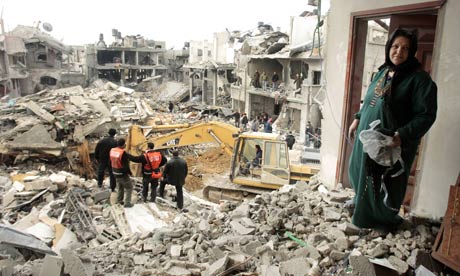Hellfire missiles and white phosphorus artillery shells among weapons used in 'indiscriminate' attacks on civilians, says human rights group
- guardian.co.uk, Monday 23 February 2009 09.14 GMT
- Article history

A Palestinian woman surveys her destroyed house after an Israeli air strike in Jabalya in northern Gaza. Photograph: Mohammed Salem/Reuters
Detailed evidence has emerged of Israel's extensive use of US-made weaponry during its war in Gaza last month, including white phosphorus artillery shells, 500lb bombs and Hellfire missiles.
In a report released today, Amnesty International listed the weapons used and called for an immediate arms embargo on Israel and all Palestinian armed groups. It called on the US president, Barack Obama, to suspend military aid to Israel.
The human rights group said those arming both sides in the conflict "will have been well aware of a pattern of repeated misuse of weapons by both parties and must therefore take responsibility for the violations perpetrated".
The US has long been the largest arms supplier to Israel; under a 10-year agreement negotiated by the Bush administration the US will provide $30bn (£21bn) in military aid to Israel.
"As the major supplier of weapons to Israel, the USA has a particular obligation to stop any supply that contributes to gross violations of the laws of war and of human rights," said Malcolm Smart, Amnesty's Middle East and North Africa programme director. "To a large extent, Israel's military offensive in Gaza was carried out with weapons, munitions and military equipment supplied by the USA and paid for with US taxpayers' money."
For their part, Palestinian militants in Gaza were arming themselves with "unsophisticated weapons" including rockets made in Russia, Iran and China and bought from "clandestine sources", it said. About 1,300 Palestinians were killed and more than 4,000 injured during the three-week conflict. On the Israeli side 13 were killed, including three civilians. Amnesty said Israel's armed forces carried out "direct attacks on civilians and civilian objects in Gaza, and attacks which were disproportionate or indiscriminate".
Israeli officials criticised the report, saying the military only used weapons that were legal under international law and did not intentionally target civilians. Israel's foreign ministry said it was "inappropriate" to compare the supply of weapons to Israel and to Hamas.
"Every effort is made to avoid having innocent civilians caught up in the crossfire between us and Hamas," said Mark Regev, spokesman for the Israeli prime minister, Ehud Olmert. "The report ignores the fact Hamas deliberately used the Palestinian civilian population as a human shield."
Palestinian militants also fired "indiscriminate rockets" at civilians, Amnesty said. It called for an independent investigation into violations of international humanitarian law by both sides.
A Hamas spokesman, Fawzi Barhoum, called the report "unfair", saying there was no comparison between the Israeli military and Palestinian "people who defend themselves with some rifles and other primitive means".
Amnesty researchers in Gaza found several weapon fragments after the fighting. One came from a 500lb (227kg) Mark-82 fin-guided bomb, which had markings indicating parts were made by the US company Raytheon. They also found fragments of US-made white phosphorus artillery shells, marked M825 A1.
On 15 January, several white phosphorus shells fired by the Israeli military hit the headquarters of the UN Relief and Works Agency in Gaza City, destroying medicine, food and aid. One fragment found at the scene had markings indicating it was made by the Pine Bluff Arsenal, based in Arkansas, in October 1991.
The human rights group said the Israeli military had used white phosphorus in densely populated civilian areas, which it said was an indiscriminate form of attack and a war crime. Its researchers found white phosphorus still burning in residential areas days after the ceasefire.
At the scene of an Israeli attack that killed three Palestinian paramedics and a boy in Gaza City on 4 January, Amnesty found fragments of an AGM114 Hellfire missile, made by Hellfire Systems of Orlando, a joint venture of Lockheed Martin and Boeing. The missile is often fired from Apache helicopters.
Amnesty said it also found evidence of a new type of missile, apparently fired from unmanned drones, which exploded into many pieces of shrapnel that were "tiny sharp-edged metal cubes, each between 2 and 4mm square in size".
"They appear designed to cause maximum injury," Amnesty said. Many civilians were killed by this weapon, including several children, it said.
Rockets fired by Palestinian militants were either 122mm Grad missiles or short-range Qassam rockets, a locally made, improvised artillery weapon. Warheads were either smuggled in or made from fertiliser.
The arsenal of weapons was on a "very small scale compared to Israel", it said, adding that the scale of rocket arsenal deployed by Hizbullah in the 2006 Lebanese war was "beyond the reach of Palestinian militant groups".
Armed for war
Israelis Missiles launched from helicopters and unmanned drones, including 20mm cannon and Hellfire missiles. Larger laser-guided and other bombs dropped by F-16 warplanes. Extensive use of US-made 155mm white phosphorus artillery shells and Israeli-made 155mm illuminating shells that eject phosphorus canisters by parachute. Several deaths caused by flechettes, 4cm-long metal darts packed into 120mm tank shells, and fragments of US-made 120mm tank shells.
Palestinians Militants fired rockets into southern Israel including 122mm Grad rockets of either Russian, Chinese or Iranian manufacture, and smaller, improvised Qassam rockets often made inside Gaza and usually holding 5kg of explosives and shrapnel.


No comments:
Post a Comment